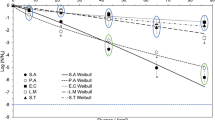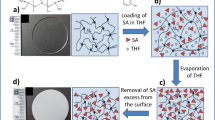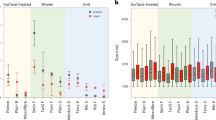Abstract
Silicone-rubber baby teats used to bottle-feed infants are frequently disinfected by moist heating. However, infant exposure to small microplastics (<10 μm) potentially released from the heated teats by hydrothermal decomposition has not been studied, owing to the limitations of conventional spectroscopy in visualizing microplastic formation and in characterizing the particles at the submicrometre scale. Here both the surfaces of silicone teats subjected to steam disinfection and the wash waters of the steamed teats were analysed using optical-photothermal infrared microspectroscopy. This new technique revealed submicrometre-resolved steam etching on and chemical modification of the teat surface. Numerous flake- or oil-film-shaped micro(nano)plastics (MNPs) (in the size range of 0.6–332 μm) presented in the wash waters, including cyclic and branched polysiloxanes or imides, which were generated by the steam-induced degradation of the base polydimethylsiloxane elastomer and the polyamide resin additive. The results indicated that by the age of one year, a baby could ingest >0.66 million elastomer-derived micro-sized plastics (MPs) (roughly 81% in 1.5–10 μm). Global MP emission from teat disinfection may be as high as 5.2 × 1013 particles per year. Our findings highlight an entry route for surface-active silicone-rubber-derived MNPs into both the human body and the environment. The health and environmental risks of the particles are as yet unknown.
This is a preview of subscription content, access via your institution
Access options
Access Nature and 54 other Nature Portfolio journals
Get Nature+, our best-value online-access subscription
$29.99 / 30 days
cancel any time
Subscribe to this journal
Receive 12 print issues and online access
$259.00 per year
only $21.58 per issue
Buy this article
- Purchase on Springer Link
- Instant access to full article PDF
Prices may be subject to local taxes which are calculated during checkout





Similar content being viewed by others
Data availability
All data supporting the findings of this study are available within the article and the Supplementary Information. Source data are provided with this paper.
Change history
31 May 2022
A Correction to this paper has been published: https://doi.org/10.1038/s41565-022-01155-8
References
Rochman, C. M. & Hoellein, T. The global odyssey of plastic pollution. Science 368, 1184–1185 (2020).
Pabortsava, K. & Lampitt, R. S. High concentrations of plastic hidden beneath the surface of the Atlantic Ocean. Nat. Commun. 11, 4073 (2020).
Isobe, A., Iwasaki, S., Uchida, K. & Tokai, T. Abundance of non-conservative microplastics in the upper ocean from 1957 to 2066. Nat. Commun. 10, 417 (2019).
Rillig, M. C. & Lehmann, A. Microplastic in terrestrial ecosystems. Science 368, 1430–1431 (2020).
Vethaak, A. D. & Legler, J. Microplastics and human health. Science 371, 672–674 (2021).
Cox, K. D. et al. Human consumption of microplastics. Environ. Sci. Technol. 53, 7068–7074 (2019).
Zhang, Q. et al. A review of microplastics in table salt, drinking water, and air: direct human exposure. Environ. Sci. Technol. 54, 3740–3751 (2020).
Hernandez, L. M. et al. Plastic teabags release billions of microparticles and nanoparticles into tea. Environ. Sci. Technol. 53, 12300–12310 (2019).
Li, D. et al. Microplastic release from the degradation of polypropylene feeding bottles during infant formula preparation. Nat. Food 1, 746–754 (2020).
Song, Y. K. et al. Horizontal and vertical distribution of microplastics in Korean coastal waters. Environ. Sci. Technol. 52, 12188–12197 (2018).
Hartmann, N. B. et al. Are we speaking the same language? Recommendations for a definition and categorization framework for plastic debris. Environ. Sci. Technol. 53, 1039–1047 (2019).
Clarson, S. J. Advances in Silicones and Silicone-Modified Materials (American Chemical Society, 2010).
Clarson, S. J. Synthesis and Properties of Silicones and Silicone-Modified Materials (American Chemical Society, 2003).
How to Prepare Formula for Bottle-Feeding at Home (WHO, 2007).
Fromme, H. et al. Siloxane in baking moulds, emission to indoor air and migration to food during baking with an electric oven. Environ. Int. 126, 145–152 (2019).
Helling, R., Kutschbach, K. & Joachim Simat, T. Migration behaviour of silicone moulds in contact with different foodstuffs. Food Addit. Contam. A 27, 396–405 (2010).
Rücker, C. & Kümmerer, K. Environmental chemistry of organosiloxanes. Chem. Rev. 115, 466–524 (2015).
Polyamide resin series developed by General Mills. Chem. Eng. News 41, 58–61 (1963).
ter Halle, A. et al. Understanding the fragmentation pattern of marine plastic debris. Environ. Sci. Technol. 50, 5668–5675 (2016).
Dawson, A. L. et al. Turning microplastics into nanoplastics through digestive fragmentation by Antarctic krill. Nat. Commun. 9, 1001 (2018).
Min, K., Cuiffi, J. D. & Mathers, R. T. Ranking environmental degradation trends of plastic marine debris based on physical properties and molecular structure. Nat. Commun. 11, 727 (2020).
Landrigan, P. J., Kimmel, C. A., Correa, A. & Eskenazi, B. Children’s health and the environment: public health issues and challenges for risk assessment. Environ. Health Perspect. 112, 257–265 (2004).
Song, Y. K. et al. A comparison of microscopic and spectroscopic identification methods for analysis of microplastics in environmental samples. Mar. Pollut. Bull. 93, 202–209 (2015).
Ivleva, N. P., Wiesheu, A. C. & Niessner, R. Microplastic in aquatic ecosystems. Angew. Chem. Int. Ed. 56, 1720–1739 (2017).
Nguyen, B. et al. Separation and analysis of microplastics and nanoplastics in complex environmental samples. Acc. Chem. Res. 52, 858–866 (2019).
Bassan, P. et al. Resonant mie scattering in infrared spectroscopy of biological materials – understanding the ‘dispersion artefact’. Analyst 134, 1586–1593 (2009).
Chan, K. L. A. & Kazarian, S. G. New opportunities in micro- and macro-attenuated total reflection infrared spectroscopic imaging: Spatial resolution and sampling versatility. Appl. Spectrosc. 57, 381–389 (2003).
Koenig, J. L. Microspectroscopic Imaging of Polymers (American Chemical Society, 1998).
Zhang, D. et al. Depth-resolved mid-infrared photothermal imaging of living cells and organisms with submicrometer spatial resolution. Sci. Adv. 2, e1600521 (2016).
Klementieva, O. et al. Super-resolution infrared imaging of polymorphic amyloid aggregates directly in neurons. Adv. Sci. 7, 1903004 (2020).
Lo, M., Marcott, C., Kansiz, M., Dillon, E. & Prater, C. Sub-micron, non-contact, super-resolution infrared microspectroscopy for microelectronics contamination and failure analyses. In Proc. IEEE International Symposium in the Physical and Failure Analysis of Integrated Circuits 1–4 (IEEE, 2020).
Diem, M., Romeo, M., Boydston-White, S., Miljkovic, M. & Matthaus, C. A decade of vibrational micro-spectroscopy of human cells and tissue (1994-2004). Analyst 129, 880–885 (2004).
Danilov, V., Wagner, H. & Meichsner, J. Modification of polydimethylsiloxane thin films in H2 radio-frequency plasma investigated by infrared reflection absorption spectroscopy. Plasma Process. Polym. 8, 1059–1067 (2011).
Launer, P. J. & Arkles, B. Silicon Compounds: Silanes and Silicones (Gelest, 2008).
Park, E. S., Ro, H. W., Nguyen, C. V., Jaffe, R. L. & Yoon, D. Y. Infrared spectroscopy study of microstructures of poly(silsesquioxane)s. Chem. Mater. 20, 1548–1554 (2008).
Song, Y. K. et al. Combined effects of UV exposure duration and mechanical abrasion on microplastic fragmentation by polymer type. Environ. Sci. Technol. 51, 4368–4376 (2017).
Larson, G. L., Hernandez, D., Montes de Lopez-Cepero, I. & Torres, L. E. The chemistry of alpha-silyl carbonyl compounds. 11. Reaction of alpha-silyl esters with grignard reagents: a synthesis of beta-keto silanes and ketones. Preparation of the douglas fir tussock moth pheromone. J. Org. Chem. 50, 5260–5267 (1985).
Charati, S. G. & Stern, S. A. Diffusion of gases in silicone polymers: molecular dynamics simulations. Macromolecules 31, 5529–5535 (1998).
Heo, Y. S. et al. Characterization and resolution of evaporation-mediated osmolality shifts that constrain microfluidic cell culture in poly(dimethylsiloxane) devices. Anal. Chem. 79, 1126–1134 (2007).
Skrovanek, D. J., Painter, P. C. & Coleman, M. M. Hydrogen bonding in polymers. 2. Infrared temperature studies of nylon 11. Macromolecules 19, 699–705 (1986).
Patsyk, A., Sivan, U., Segev, M. & Bandres, M. A. Observation of branched flow of light. Nature 583, 60–65 (2020).
Hamdani, S., Longuet, C., Lopez-Cuesta, J. & Ganachaud, F. Calcium and aluminium-based fillers as flame-retardant additives in silicone matrices. I. Blend preparation and thermal properties. Polym. Degrad. Stabil. 95, 1911–1919 (2010).
Bartels, T. T. The Sadtler handbook of infrared spectra. J. Chromatogr. Sci. 16, 21A (1978).
Stock, V. et al. Uptake and effects of orally ingested polystyrene microplastic particles in vitro and in vivo. Arch. Toxicol. 93, 1817–1833 (2019).
Tan, H., Yue, T., Xu, Y., Zhao, J. & Xing, B. Microplastics reduce lipid digestion in simulated human gastrointestinal system. Environ. Sci. Technol. 54, 12285–12294 (2020).
Magrì, D. et al. Laser ablation as a versatile tool to mimic polyethylene terephthalate nanoplastic pollutants: characterization and toxicology assessment. ACS Nano 12, 7690–7700 (2018).
Luo, T. et al. Maternal polystyrene microplastic exposure during gestation and lactation altered metabolic homeostasis in the dams and their F1 and F2 offspring. Environ. Sci. Technol. 53, 10978–10992 (2019).
Jacob, H., Besson, M., Swarzenski, P. W., Lecchini, D. & Metian, M. Effects of virgin micro- and nanoplastics on fish: trends, meta-analysis, and perspectives. Environ. Sci. Technol. 54, 4733–4745 (2020).
Gu, W. et al. Single-cell RNA sequencing reveals size-dependent effects of polystyrene microplastics on immune and secretory cell populations from zebrafish intestines. Environ. Sci. Technol. 54, 3417–3427 (2020).
Mahler, G. J. et al. Oral exposure to polystyrene nanoparticles affects iron absorption. Nat. Nanotechnol. 7, 264–271 (2012).
Barness, L. A. The importance of fats and fatty acids in infant nutrition. Curr. Med. Res. Opin. 4, 28–32 (1976).
Clemente, JoseC. et al. The impact of the gut microbiota on human health: an integrative view. Cell 148, 1258–1270 (2012).
Nowarski, R., Jackson, R. & Flavell, R. A. The stromal intervention: regulation of immunity and inflammation at the epithelial-mesenchymal barrier. Cell 168, 362–375 (2017).
Acknowledgements
This work was supported by the Key-Area Research and Development Program of Guangdong Province (grant no. 2020B1111380003 to R.J.) and the National Natural Science Foundation of China (grant nos. 31861133003 to R.J. and 21607072 to Y.S.). We thank C. Wang (Nanjing University) for his assistance with the IR spectra analysis and M. K. F. Lo (Photothermal Spectroscopy Corp.) for technical support. B.X. acknowledges the UMass Amherst Conti Faculty Fellowship.
Author information
Authors and Affiliations
Contributions
Y.S. carried out the experiments and wrote the original manuscript. X.H. and H.T. supported the O-PTIR and low-voltage SEM analyses. K.L. supported ESEM/EDS collection and XPS spectra analysis. H.L. supported MP counting. S.L. contributed to experimental planning and data interpretation. Y.S., B.X. and R.J. contributed to experimental planning, data analysis and interpretation, and manuscript revision. All authors reviewed and approved the paper.
Corresponding authors
Ethics declarations
Competing interests
The authors declare no competing interests.
Additional information
Peer review information Nature Nanotechnology thanks Ji-Xin Cheng, Oxana Klementieva and the other, anonymous, reviewer(s) for their contribution to the peer review of this work.
Publisher’s note Springer Nature remains neutral with regard to jurisdictional claims in published maps and institutional affiliations.
Supplementary information
Supplementary Information
Supplementary Notes 1–7, Tables 1–4 and Figs. 1–13.
Supplementary Data
Data for Supplementary Figs. 2b, 3b, 3d, 5a, 5b, 6b, 8c, 9c and 12b.
Source data
Source Data Fig. 1
Statistical source data.
Source Data Fig. 2
Statistical source data.
Source Data Fig. 3
Statistical source data.
Source Data Fig. 4
Statistical source data.
Source Data Fig. 5
Statistical source data.
Rights and permissions
About this article
Cite this article
Su, Y., Hu, X., Tang, H. et al. Steam disinfection releases micro(nano)plastics from silicone-rubber baby teats as examined by optical photothermal infrared microspectroscopy. Nat. Nanotechnol. 17, 76–85 (2022). https://doi.org/10.1038/s41565-021-00998-x
Received:
Accepted:
Published:
Issue Date:
DOI: https://doi.org/10.1038/s41565-021-00998-x
This article is cited by
Machine learning driven methodology for enhanced nylon microplastic detection and characterization
Scientific Reports (2024)
Analysis of aged microplastics: a review
Environmental Chemistry Letters (2024)
Occurrence and Distribution Characteristics of Microplastics in Surface Water of China: a Review
Water, Air, & Soil Pollution (2024)
Far-field super-resolution chemical microscopy
Light: Science & Applications (2023)
Oligomer nanoparticle release from polylactic acid plastics catalysed by gut enzymes triggers acute inflammation
Nature Nanotechnology (2023)



